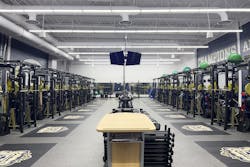ARCHITECTURAL SSL | Visible-light disinfection cleans up school sports
According to the National Federation of State High School Associations’ and the Sports Medicine Advisory Committee’s “Guidance for opening up high school athletics and activities,” decreasing potential exposure to respiratory droplets is critical to preventing the spread of COVID-19 in athletic facilities. It recommends “adequate cleaning schedules should be created and implemented for all athletic facilities to mitigate any communicable diseases; and prior to an individual or groups of individuals entering a facility, hard surfaces within that facility should be wiped down and sanitized (chairs, furniture in meeting rooms, locker rooms, weight room equipment, bathrooms, athletic training room tables, etc.).”
In 2019, voters in Chelsea, Mich., approved an $81 million school bond issue, paving the way for several projects, including a new auxiliary gymnasium to relieve an overcrowded facility at the high school. The school district planned to improve its weight training offerings for students and expand access for middle-school athletes and the community. The new facility would include two basketball practice courts, a competition court, and a 6,500-square-foot weight room.
Engineer Rich Coburn, a project manager at Strategic Energy Solutions, in Berkley, Mich., along with project architect Kingscott, in Kalamazoo, Mich., knew the weight room would be a popular destination and prioritized occupant health and safety in its design. Exercise facilities are considered high risk for transmission because of their enclosed environment, shared equipment, and close contact between users and staff. “There are always concerns about germs and bacteria when you create spaces such as weight rooms,” Coburn says. “When this project came up, it seemed like the perfect space to utilize 405-nm lighting technology.”
Using a combination of 405-nm indigo and white LEDs, Coburn specified Kenall Manufacturing’s Millenium Stretch luminaires, which use Kenall’s dual-mode Indigo-Clean technology to emit narrow spectrum light that kills viruses and bacteria while providing ambient illumination for the space. The luminaires use this wavelength, which falls into the visible light spectrum, to continuously deactivate harmful microbes in the air and on surfaces. When the space is occupied, the luminaires operate in white disinfection mode. When the facility is closed, the fixtures switch to indigo light to provide a higher level of disinfection.
Standard room occupancy sensors control the operating mode, and the electrical inputs are identical to a typical LED luminaire. The continuous whole-room disinfection technology kills many harmful pathogens, including SARS-CoV-2, influenza A, and methicillin-resistant Staphylococcus aureus (MRSA).
Disclosure: The author is chief scientist and head of clinical affairs for Indigo-Clean at Kenall Manufacturing.
READ FULL VERSION: architecturalssl.com/33000433
For up-to-the-minute LED and SSL updates, follow us on Twitter. You’ll find curated content and commentary, as well as information on industry events, webcasts, and surveys on our LinkedIn page and our Facebook page.
Clifford Yahnke | Chief Scientist, Indigo-Clean, Kenall
CLIFFORD J. YAHNKE, PhD, chief scientist and head of clinical affairs for Indigo-Clean and Kenall Manufacturing, may be reached at [email protected]. Indigo-Clean is a registered trademark of Kenall Manufacturing Co., a Legrand company. Kenall was founded in Chicago in 1963 and has built a reputation for durable lighting solutions. Today, the company creates solutions for the healthcare, cleanroom/containment, food processing, transportation, high abuse, and correctional lighting markets. Kenall luminaires are designed in Kenosha, Wisconsin, and comply with the Buy American Act (manufactured in the United States with more than 50% of the component cost of US origin). For additional information, visit indigo-clean.com.





![The DesignLights Consortium continues to make progress in shifting outdoor lighting products and implementation practices toward a more restrained and thoughtful strategy. [Image does not represent a DLC qualified fixture.] The DesignLights Consortium continues to make progress in shifting outdoor lighting products and implementation practices toward a more restrained and thoughtful strategy. [Image does not represent a DLC qualified fixture.]](https://img.ledsmagazine.com/files/base/ebm/leds/image/2024/08/66be810888ae93f656446f61-dreamstime_m_265700653.png?auto=format,compress&fit=&q=45&h=139&height=139&w=250&width=250)
